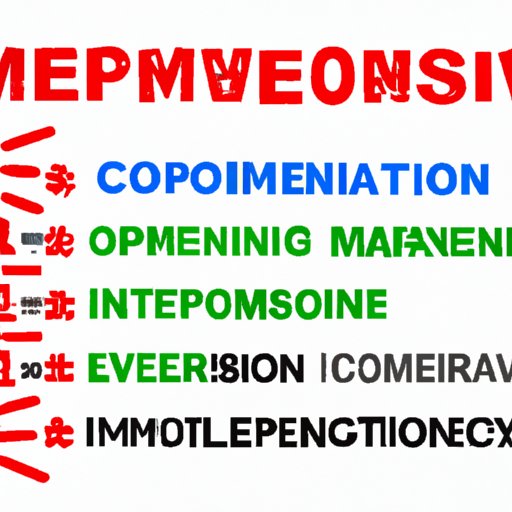
Introduction
YouTube has become a major source of income for many content creators. However, determining how much money you can earn per view is not always straightforward. From CPM to demographic targeting, there are a variety of factors that impact your earnings. In this article, we’ll unpack YouTube’s revenue sharing model and explore how much money you can realistically make per view. We’ll also share tips for optimizing your revenue and increasing your earnings.
The Truth About YouTube Earnings: How Much You REALLY Make Per View
Before we dive into the specifics, let’s take a look at how YouTube’s revenue sharing model works. YouTube’s Partner Program allows creators to monetize their content through ads. Creators earn a percentage of the revenue generated by ads displayed on their videos. The exact percentage varies, but creators typically earn 55% of the ad revenue, while YouTube keeps the other 45%. This means that for every $100 generated by ads on your video, you’ll earn $55.
The amount you earn per view, however, is not a set number. It’s dependent on a variety of factors, including CPM, audience demographics, and the ad format. The real key to earning money on YouTube is by accumulating views. The more views you have, the more money you can make.
Breaking Down YouTube’s Revenue Sharing Model: How Much Are Creators Paid Per View?
Now that we know the basics of YouTube’s revenue sharing model, let’s explore how much creators actually earn per view. YouTube calculates earnings based on CPM (cost per mille), which is the cost an advertiser pays per thousand views of their ad. While the exact CPM can vary depending on numerous factors, such as ad quality and advertiser demand, typical YouTube CPM rates range from $0.30 to $4.00. As a creator, you earn a percentage of this CPM based on the number of impressions your video receives.
Impressions are the number of times an ad appears on your video. The more impressions you have, the more money you’ll make. The ad format also plays a role in determining earnings. Formats like skippable pre-roll ads generally have higher CPMs and can generate more revenue per view than banner ads or display ads.
So, let’s run through an example. If your video has a CPM of $2.00 and receives 10,000 views, you’ll earn $20 in ad revenue. That may not seem like a lot, but if you consistently generate that many views, your earnings can quickly add up. Some creators even earn a full-time income from their YouTube channels.
Is it Worth it? Calculating Your Potential YouTube Earnings Per View
If you’re considering starting a YouTube channel, it’s important to understand your earning potential. Calculating your potential YouTube earnings per view involves a few factors, including CPM, impressions, and other metrics. Traffic and audience demographics can also have a significant impact on your earnings. For example, if you have a larger audience in a high-income country, like the United States, you’ll likely earn more per view than if your audience was primarily located in a lower-income country.
It’s important to note that while some creators earn significant amounts of money through YouTube, it’s not a guaranteed source of income. Advertiser demand can fluctuate, and YouTube can change its policies at any time. As with any career or business, it’s important to have a backup plan and to diversify your revenue streams when possible. However, if you’re willing to put in the effort to consistently create quality content and market yourself effectively, YouTube can be a lucrative revenue source.
How to Increase Your YouTube CPM and Earn More Money Per View
If you’re looking to optimize your earnings per view, there are several strategies you can implement. First and foremost, focus on creating high-quality content that resonates with your audience. The longer people watch your videos, the more ad impressions you’ll generate, which can increase your earnings. Additionally, you can optimize your metadata, such as your video title and descriptions, to increase the likelihood of your videos appearing in search results. This can help drive more views and ad impressions.
Monetization and views also relate to CPM. If your videos consistently demonstrate a high level of viewer engagement, YouTube may prioritize your content for more valuable ads. This means that by producing quality content, you’ll likely attract higher-paying advertisers. Similarly, if you’re able to drive more traffic to your videos, you’ll increase the number of impressions and generate more revenue.
One example of a channel that has optimized their CPM is “The Slow Mo Guys,” a science and technology channel. By consistently producing visually stunning content and offering unique perspectives, their videos generate high engagement levels. As a result, they’ve attracted high-paying advertisers and earn an estimated $36,000 per month in ad revenue alone.
Unpacking YouTube’s Advertiser-Friendly Guidelines and Its Impact on Your Earnings Per View
YouTube’s advertiser-friendly guidelines can have a significant impact on your earnings per view. These guidelines outline what content is considered “brand-safe” and is acceptable for advertisers. If your content doesn’t meet these guidelines, it may be ineligible for monetization. Avoiding topics like sensitive social issues, violence, and adult content will help ensure your content meets the guidelines.
While adhering to the guidelines may limit the type of content you can create, it’s an essential consideration for creators looking to make income through their channels. Violating the guidelines can result in demonetization or even channel termination, both of which can have significant financial effects.
Conclusion
In conclusion, while there’s no set amount of money you can earn per YouTube view, understanding YouTube’s revenue sharing model, CPM, and audience demographics can help you estimate your earning potential. Increasing your CPM and driving more traffic to your videos can help increase earnings, while maintaining advertiser-friendly guidelines is essential for sustained revenue. Ultimately, while YouTube can be a lucrative source of income, it’s important to have a backup plan and diversify your revenue streams.




